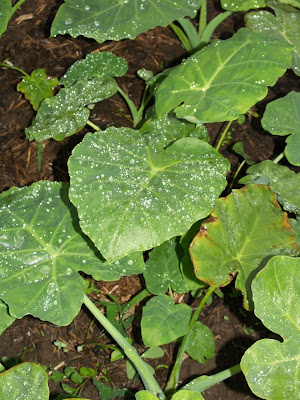 Xanthosoma brasiliense syn Colocasia gigantea
Xanthosoma brasiliense syn Colocasia giganteaTahitian Spinach / Celery Stem Taro / Callaloo / Belembe
I have planted this variety of taro in my community garden plot and it is one which is grown for its edible leaves and leaf stem (petiole) and not for the tuber or yam as in other varieties. There is confusion over the botanical name with some sources listing it as Xanthosoma and others including it with Colocasia. The vernacular French name callaloo or calalou has its origin in the Caribbean (it's also called Carib cabbage) and a soup of that name is very popular in the West Indies. It is also eaten like spinach in Puerto Rico, Haiti, the Lesser Antilles, southern Brazil and Hawaii. The leaf stems and leaves are also used throughout Asia and the Pacific Islands and as a cooked green it provides an excellent source of vitamin C (142mg per 100g), vitamin A, calcium, potassium, phosphorous and iron. It is also rich in protein (4.4mg per 100g) with most of the essential amino acids present. It is important to note that taro leaves and stems should never be eaten raw and a long cooking time is recommended to eliminate the acrid "twang" of calcium oxalate crystals contained in the plant which can cause irritation to the mouth and throat. Asian food expert Charmaine Solomon gives a first hand account of her experience of eating undercooked taro leaves as 'the sensation of a hundred red hot needles in my throat'. Only the Japanese have the technique for using it raw, finely sliced with sushi and given the name of zuiki. The experience and itching sensation on the mucous membranes described as egumi (mi meaning taste).
Taro is easy to grow as long as it gets lots of water and is provided with a humus rich soil. It may go dormant in cool climates over winter though its origin as a jungle plant means it can tolerate the short days and low light levels of winter.
I have yet to experiment with cooking it but have found an excellent Indian recipe from the blog of Soumya's kitchen. In India taro is called arvi or patra. Here is the link:
Taro is easy to grow as long as it gets lots of water and is provided with a humus rich soil. It may go dormant in cool climates over winter though its origin as a jungle plant means it can tolerate the short days and low light levels of winter.
I have yet to experiment with cooking it but have found an excellent Indian recipe from the blog of Soumya's kitchen. In India taro is called arvi or patra. Here is the link:
I have a purple variety of taro which is highly prized for its non- scratchy taste. My friends take the leaves from my garden and make tasty dishes, but I am scared to taste it as I am highly allergic to it:(
ReplyDeleteMy mom had a patch of Zuiki in her garden and Ive been saving a corner of my garden for my own patch. Now if I can only find some starter plants! Im on Oahu so you'd think it would be an easy thing to find.
ReplyDeleteThanks for posting your info.
Julie
Hello! Someone in my Facebook group shared this site with us so I came to give it a
ReplyDeletelook. I'm definitely enjoying the information. I'm bookmarking and will be tweeting this to my followers! Wonderful blog and excellent style and design.
my web site: ταρω προβλεψεις